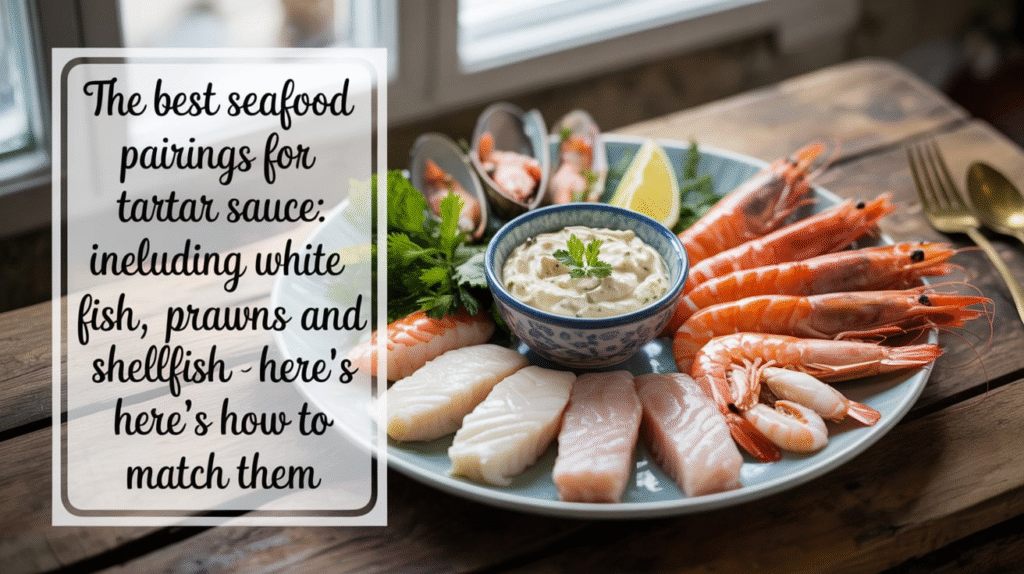Affiliate Disclosure: PantryBrands.co.uk is a participant in the Amazon.co.uk Associates Programme. As an Amazon Associate, we earn from qualifying purchases made through links on this site.
Tartar sauce pairs best with flaky white fish (think cod and haddock), crispy prawns/scampi, and briny shellfish, because its creamy, lemony tang cuts through oil and enhances clean, sea‑fresh flavours. Start with a classic tartar for fried white fish, a dill‑forward version for salmon, and a caper‑heavy one for shellfish, then adjust acidity to taste.

Why tartar sauce works so well with seafood
Tartar sauce succeeds because it balances richness and brightness, giving fried or oily seafood a lift while preserving its delicate character.
The flavour profile that flatters fish
A good tartar sauce is creamy and tangy with subtle herbal notes. Here’s why this combination complements seafood:
- Acidity (lemon juice, gherkins, capers) sharpens flavours and minimises any oiliness.
- Herbs (dill, parsley, chives) add freshness without overwhelming the fish’s natural sweetness.
Texture contrast that keeps each bite interesting
Beyond flavour, texture matters in every mouthful.
- Creamy body offsets a crisp batter or breadcrumb coating.
- Fine chopped mix‑ins (gherkin, caper) provide pleasant pops that mirror the crunch of fried coatings.
A British classic made better
Fish and chips are iconic for a reason: hot, flaky white fish loves a cool, tangy tartar.
- Battered cod or haddock meet their match in a lemon‑bright, caper‑studded sauce.
- Chunky chips benefit from a dab of tartar on the side to tie the plate together.
Best seafood pairings by type
Different seafood calls for slightly different emphases in your tartar sauce—here’s how to match confidently.
Cod and haddock (fried or baked)
These mild, flaky white fish are the gold‑standard pairing for classic tartar.
- Fried versions shine with a standard mayo‑based tartar: lemon, capers, gherkin, and parsley.
- Oven‑baked fillets welcome an extra squeeze of lemon and a touch more dill for freshness.
Plaice, sole and other flatfish
Delicate flatfish need a lighter hand so the sauce doesn’t dominate.
- Keep it subtle: finer chop on gherkins/capers and a looser texture with a little extra lemon juice.
- Serve sparingly: a thin smear or side dish lets the buttery fish remain centre stage.
Prawns, scampi and langoustines
Sweet, juicy crustaceans love a brisk, lemony sauce with a hint of bite.
- For scampi: add a touch of Dijon to the tartar—just enough heat to perk up the crumb.
- For cold prawns: fold in finely chopped dill and extra capers for briny brightness.
Salmon and trout
Richer, oilier fish need greener herbs and a sharper citrus edge.
- Dill‑forward tartar suits salmon’s depth; balance with lemon zest for perfume, not just juice.
- Smoked trout prefers a thinner, crème‑fraîche‑cut tartar to avoid over‑richness.
Calamari, octopus and cuttlefish
Clean, lightly sweet cephalopods benefit from lift and crunch.
- For fried calamari: keep tartar thick so it clings to rings; finish with fresh parsley.
- For grilled octopus: use a looser tartar with extra lemon to echo char and smokiness.
Crab cakes and fish cakes
These already flavourful patties welcome a crisp, herby counterpoint.
- Crab cakes like a caper‑heavy tartar with a dash of mustard.
- Fish cakes (e.g., cod and potato) pair well with tartar that’s sharper rather than sweeter.
Choosing the right tartar style for each pairing
Small tweaks transform one base sauce into multiple perfect matches. Below are practical levers to pull.
Classic house tartar (your baseline)
Start here for almost everything, then tweak per seafood.
- Core build: good mayonnaise, lemon juice, chopped gherkins, capers, parsley, pinch of salt and pepper.
- When to use: battered cod, haddock, plaice, or mixed fried platters.
Dill‑forward tartar for richer fish
Dill adds lift and a green, anise‑flecked freshness.
- Best for: salmon, trout, cold poached fish, prawn cocktails.
- Balance tip: add lemon zest and a tiny splash of white wine vinegar to cut oiliness.
Mustard‑kissed tartar for fried crustaceans
A hint of heat and depth keeps each bite lively.
- Best for: scampi, langoustines, calamari.
- Balance tip: use Dijon sparingly; you’re after brightness, not a mustard sauce.
Extra‑briny tartar for shellfish
Amplify the sea‑spray character without turning the sauce too salty.
- Best for: crab cakes, cold prawns, smoked fish.
- Balance tip: increase capers slightly and counter with a touch more lemon.
Serving and plating tips
Presentation and temperature dramatically influence how the sauce performs.
Temperature, thickness and timing
Keep textures deliberate and consistent.
- Chill the sauce for at least 30 minutes before serving so flavours meld and body firms up.
- Match thickness to the dish: thicker for fried foods (so it clings), looser for grilled or poached fish.
Portioning and side strategy
A little thought prevents muddle on the plate.
- Serve on the side to let diners control intensity and keep batter crisp.
- Add bright sides—lemon wedges, crisp salad leaves, or pickled onions—to echo tartar’s acidity.
Chips and the supporting cast
Classics remain classics because they work.
- Chunky chips or triple‑cooked chips appreciate a dab of tartar as much as the fish.
- Mushy peas or minted peas add sweetness and freshness that round out the plate.
Common mistakes to avoid
Steer clear of these pitfalls to keep the pairing balanced and elegant.
Going too sweet or too coarse
Tartar should be savoury‑bright, not sugary or bulky.
- Avoid sweet American‑style relishes; opt for British gherkins/cornichons instead.
- Chop finely so the sauce spreads evenly and doesn’t pull fish from its coating.
Overpowering delicate fish
Let the seafood lead, the sauce follow.
- Use restraint with flatfish—lighter, thinner tartar keeps nuance intact.
- Mind the salt if seafood is already seasoned, smoked or brined.
Quick adjustments for different occasions
You don’t need a new recipe—just sensible tweaks.
For a lighter summer plate
Keep it zesty and herb‑forward.
- Swap some mayonnaise for Greek yoghurt or crème fraîche for a fresher profile.
- Add cucumber (seeded and finely diced) for cool crunch with grilled fish.
For a pub‑style platter
Lean into richness and boldness.
- Add extra capers and parsley for punch.
- Finish with lemon zest so the aroma lifts through steam from hot fried fish.
FAQs
Here are some questions and answers about tartar sauce pairings with seafood.
What seafood goes best with tartar sauce?
Flaky white fish (cod, haddock, plaice), fried prawns/scampi, crab cakes and fried calamari pair best because tartar’s lemony creaminess cuts oil and highlights clean, sweet seafood flavours.
Is tartar sauce suitable for salmon?
Yes—use a dill‑forward tartar with extra lemon zest or a crème‑fraîche blend to balance salmon’s richness without masking its flavour.
Should tartar sauce be thick or thin?
Match texture to the dish: thick for fried foods so it clings; looser for grilled, baked or poached fish to drizzle without overwhelming.
Can I pair tartar sauce with oysters?
It’s uncommon; oysters are usually served with mignonette or lemon. If you prefer tartar, keep it very light and lemony so it doesn’t dominate the oyster’s briny delicacy.
What herbs work best in tartar sauce for seafood?
Dill for salmon and prawns, parsley and chives for white fish, and a touch of tarragon or chervil for shellfish—used sparingly to avoid overpowering.
How do I stop tartar sauce from making batter soggy?
Serve it on the side, keep it chilled and thick, and add it at the table just before eating. This preserves the crunch of battered or breaded seafood.
